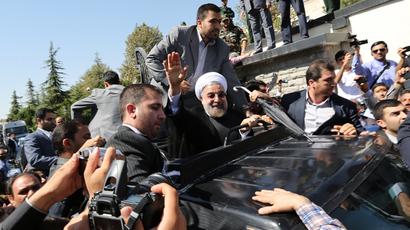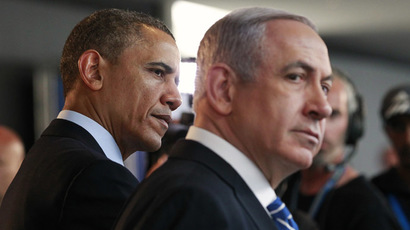Death to America? Iran divided on anniversary of US embassy takeover
The 34-year anniversary of the US Embassy takeover in Tehran drew tens of thousands to the largest anti-American rally in years. The size of the demonstration, however, belies the fact that Iranian society is deeply divided over rapprochement with the US.
Early Monday morning, large crowds formed around the former embassy’s brick walls, which are covered front to back in elaborate anti-American murals.
The seemingly hackneyed chant of “Death to America” was met with the usual stage props: the Stars and Stripes trampled underfoot alongside images of Barack Obama, banners declaring ‘The US is the Great Satan,’ and placards depicting the United States under the thumb of Israel.
Some protest paraphernalia was more topical and creative. Students, for example, carried a model of a centrifuge used in uranium enrichment. A slogan scrawled across it read: “Result of resistance against sanctions: 18,000 active centrifuges in Iran.”
And it is the country’s controversial nuclear program that lays
at the nexus of not only Monday’s demonstration, but internal
divisions which, more than anything else, explain the popularity
of Monday’s rally.
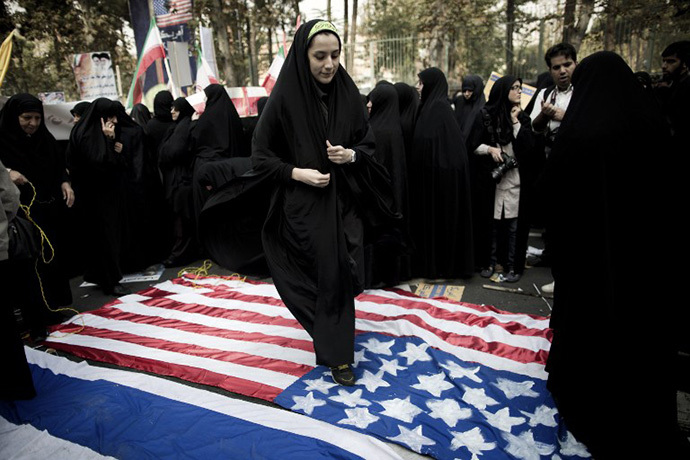
Walk the line
The anniversary of the 1979 siege, which saw student
activists scale the embassy compound’s foreboding walls and take
52 embassy staff hostage for 444 days, was an expression of pure
revolutionary zeal.
But revolutionary zeal often follows a line of Hegelian
dialectic, whereby things have a habit of transforming into their
opposites.
Nowadays, the iconic mural depicting the Statue of Liberty with a
death’s head mask is juxtaposed with smiling tourists in Gap
sweatshirts reveling in the photo-op.
Jason Rezaian, writing for the Washington Post depicts an equally
absurd encounter at the old embassy grounds, which is closed to
the public except in the week leading up to the November 4
commemoration.
When American tourists exploring the scene of “terrorism and anarchy” asked whether they could see a bit more of the grounds, guide Mohammad Reza Shoghi answered “Why not? It belongs to you.’’
The pageantry of anti-Americanism, which often provides the perfect foil for enemies of the Islamic Republic happy to compartmentalize a country in 20-second world updates, misrepresents the reality on the ground for any Westerner who visits the country.
Its population is overwhelmingly young, urban, educated and
Internet savvy. Just suggesting that they are even superficially
out of the loop of global trends is a surefire remedy to incite
their derision, as Israeli Prime Minister Netanyahu recently proved.
Despite their view as being at the epicenter of human civilization, Iranians feel painfully and unjustly isolated from the world. Theirs is a country which in antiquity was heralded for returning the Jewish population to Jerusalem after 70 years of captivity in Babylon, only to be accused in modernity of wanting to “wipe Israel off of the map".
In this context, the struggle over rapprochement with the US is far less a matter of if, and much more an issue of how.
On Sunday, Ayatollah Ali Khamenei, Iran’s superlative
religious and political authority, warned hardliners in the
country not to undermine upcoming nuclear negotiations in the
West.
"No one should consider our negotiators as
compromisers," Khamenei said in a thinly veiled reference to
President Hassan Rouhani. "They have a difficult mission
and no one must weaken an official who is busy with work."
Hardliners cast aspersion towards Rouhani for his overtures towards the United States, having been especially riled by a brief but historic phone call between him and President Barack Obama in September.
Upon returning to Tehran following the first direct contact between a US and Iranian president in more than 3 decades, Rouhani inspired a mixed reception. While the majority seemed supportive of his reengagement with the world, dubbing him a man of change, dozens more attempted to pelt him with eggs…and at least one shoe.
The protest choir antiphonally baited each other, with
chants of “Long live Rouhani, man of change!” being
greeted with shouts of “Our people are awake and hate
America!”
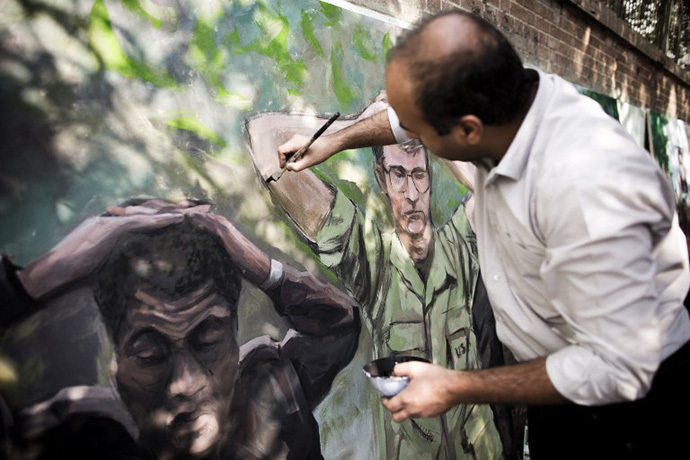
‘Den of espionage’
Belief that America is an untrustworthy party in negotiations runs deep in contemporary history, being echoed from the streets to the very heart of political power.
The embassy compound itself has been christened “the Den of Espionage,” as the top floor of its consular section was believed to house a CIA unit tasked with spying on Iran.
Khamenei himself embraced this sentiment on Sunday while praising the militant students for storming America’s diplomatic mission several decades prior.
"Thirty years ago, our young people called the US Embassy a 'den of spies'... It means our young people were 30 years ahead of their time," he said in reference to recent revelations that the US has spied on 35 foreign leaders, including allies.
Kayhan, a conservative media outlet with a hardline bent, warned on Saturday against trusting the United States and cited signs that "the Americans are aiming to trick the Islamic Republic" in the next round of nuclear negotiations in Geneva this week.
Khamenei, however, has chosen to walk a careful balancing act between embracing revolutionary motifs which characterize America within the Islamic Republic’s creation narrative, while going forward with negotiations which could loosen the West’s vicelike grip of sanctions on the country.
This balancing act has brought forth the inherent contradictions stemming from Iran’s precarious position. While the November 4th protests have in fact waned in recent years, forcing authorities to bus in students to fill out the crowds, the popularity of Monday’s demonstration is less a sign that hardliners are winning, than anxiety about the future.
Leading up to the anniversary, a Tehran municipal official actually ordered the removal of some anti-American billboards that had been erected.
One such poster depicted an Iranian negotiator sitting at a table
across from a US official who is wearing a suit jacket, but also
army fatigues and boots, with a caption that reads, "American
Honesty".
And while Khamenei has fought to bolster Rouhani and warned hardliners against scuttling negotiations, in the same speech he mirrored the sentiments of the posters which municipal authorities took down.
“The Americans smile and express desire for negotiation; on the other hand, they immediately say that all options are on the table," he said in reference to US President Barack Obama, who vowed in September to use all means at his disposal, “ including military options, in terms of making sure that we do not have nuclear weapons in Iran."
"We should not trust a smiling enemy," Khamenei warned, as the students who gathered at his residence to hear him speak chanted "Death to America".
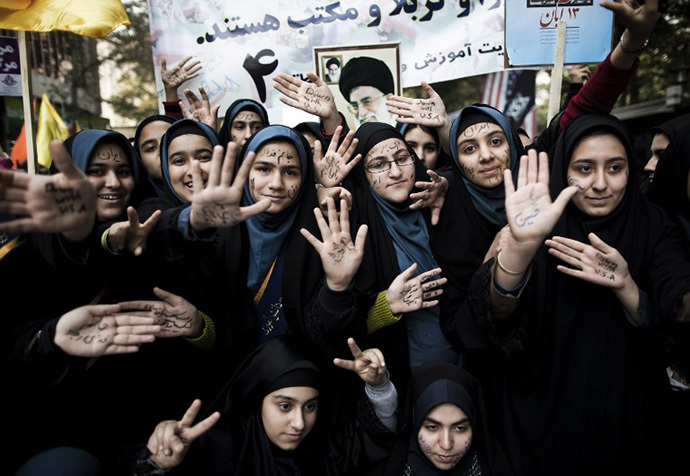
Death to America! (symbolically that is)
Even the perennial “Death to America” slogan, popularized by Ayatollah Khomeini in 1978, has come under fire.
Moderates who back President Rouhani have argued it’s time to retire the phrase now and forever. Hardliners, meanwhile, believe the chant is acutely apropos.
“Death to America means death to arrogance, death to violence. Death to America is a symbol," Reuters cites former chief nuclear negotiator ,Saeed Jalili, as telling a crowd on Monday. "The Iranian people turned it into a symbol for seeking freedom and seeking independence," he said.
The hardened war veteran and political hardliner warned that the embassy takeover several decades prior had laid bare US diplomatic missions worldwide as nothing more than “a place of espionage and hatching plots."
“The capture of the nest of spies showed that the revolution
was on the right path."

At the crux of Iran’s internal conflict is the fear that Rouhani will sell Iran’s self-declared “inalienable right” to uranium enrichment down the river, merely to lift painful sanctions which they view as unjust to begin with.
Monday’s demonstration is meant as a message to Khamenei that opponents of the tentative thaw with the US won’t back down. But the issue is not about embracing the “Great Satan.” The question is, will Rouhani, who campaigned on playing the good cop to Mahmoud Ahmadinejad’s bad cop, bring the Islamic Republic back into the international fold without diminishing the country’s hard-earned parity forged in antiquity?
Until that question is answered, he will continue to be a leader who is heralded as a savior from one side of the street, while pelted with eggs from the other.
William Echols, RT













